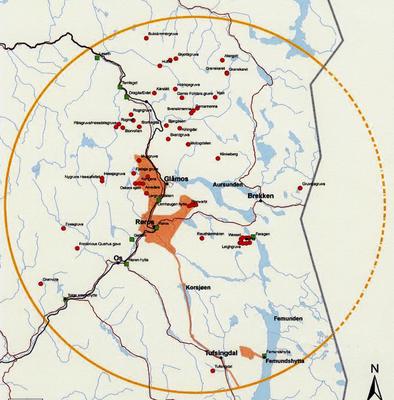Kirsti Jordet
The old 5 step process for smelting was in use for most of this time and it carried on until approximately 1890.
Where did the ore come from? Most of it was mined in the Storwartz area and the Nordgruvene, (Northern Mines), that is to say not far from the main smelting house. Seresse emphasises that the Nye Storwartz mine was, from 1708, largely responsible for steady economic results for the Company. However, there was a continuous search for new deposits of ore. Rock finders (prospectors) were on the payroll and a man called Brun Nissen tells us that in 1789 there was a prospecting gang of 350 men who each had a delegated area in which to search.
Typical for the area of Røros is that there are very many different deposits, but usually fairly small. The area within the 1646 circumference had the richest deposits, in addition to the mines at Røros the Company also operated a mine in Killingdal in Aalen for a short period around 1800. To the south of Røros, in Dalsbygda and Vingelen, some mines were operated for a few years. Outside the circumference of 1646 the largest deposit was at Kvikne (not worked by the Company in Røros) and Foldal, which the Company owned and operated from 1826-1848, but they had no great faith in the results.
It was not the lack of copper ore that slowed production in Røros. It was access to supplies of timber that was the problem. The deposits of ore within the circumference were, in the main, adequate. The total Company production of raw copper ore has been estimated to 6,000,000 tons (Killingdal 3,000,000) and pure copper, 120,000 tons (Killingdal 50,000 tons) Using present day methods Tverrfjellet and Hjerkin produced 20,000,000 tons of raw copper ore in 30 years of working. However, it is to be remembered that the vast majority of ore was mined during the ‘old period’ that is to say, prior to 1890.
Røros Copper Works became Norway’s major producer of copper from the end of the 1600s, and by 1814 there was no other Danish- Norwegian company that supplied the state with such high export income.
Literature
Espelund: ”Kobber i Det Nordenfjeldske Bergamt” (1998)
Brun Nissen: ”Røros Kobberverk 1644-1674” (1976)
K. Jordet: :”Særtrekk ved kobberverksdrifta ca 1630-1890” (2003)
This is a part of:
